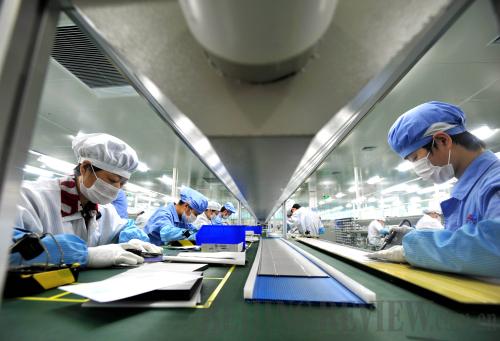|
 |
|
TARGETING HI-TECH: A workshop of a thin-film solar cell plant in Jiangxi Province. Hi-tech sector has become a hotspot of FDI in China (ZHOU KE) |
Foreign direct investment (FDI) in China reached a historic high of $124 billion in 2011, ranking second in the world only after the United States, according to the World Investment Report 2012 released by the United Nations Conference on Trade and Development (UNCTAD) in July.
However, FDI growth in China is facing a gradual slowdown. It stood at 8 percent year on year in 2011, less than the global growth of 16 percent and an 11-percent growth in developing countries, according to the UNCTAD report.
The downward trend has yet to correct itself in 2012. From January to May 2012, newly established foreign-invested enterprises in China numbered 9,261, a year-on-year decline of 12.16 percent. During that period, paid-in FDI was $47.11 billion, a 1.91-percent year-on-year decrease, according to the Chinese Ministry of Commerce (MOFCOM).
"Difficulties and uncertainties in the world economy have created a stumbling block as China tries to attract more foreign investment," said Zhan Xiaoning, Director of the Investment and Enterprise Division at UNCTAD.
Behind the decline
Several factors are contributing to China's FDI slowdown, said Wang Chao, Vice Minister of Commerce, during a press conference on July 10.
The lingering eurozone debt crisis has added uncertainties and instabilities to the world economy and is one of the major reasons for China's FDI decline. Also, emerging economies are enjoying a faster growth, leading multinationals to shift their targets to places like India, Brazil and Russia. Increasing production costs in China, limited land resources and rising wages may be the biggest culprit as investors look elsewhere in the world to park their money, said Wang.
Four economies of the Association of Southeast Asian Nations (ASEAN)—Brunei Darussalam, Indonesia, Malaysia and Singapore—saw a considerable rise in overseas investment. Overall, as East Asian countries led by China have continued to experience rising wages and production costs, the relative competitiveness of ASEAN in manufacturing has been enhanced. Accordingly, some foreign affiliates in China's coastal regions are moving to Southeast Asia, said the UNCTAD report.
Amid the debt crisis turmoil, the destination of global FDI has been altered.
"Globally, European enterprises have had less ability for foreign investment since the crisis. What's more, the United States has launched a campaign to retrieve U.S. capital and encourage it to flow back to the country to revitalize sectors such as manufacturing. U.S. enterprises also increased investment in Europe during the eurozone debt crisis. Emerging economies, such as India, Brazil and Russia, have become a new hotspot for multinationals' strategic layout. All these elements have jointly changed the orientation of global FDI," said Shen Danyang, spokesman for MOFCOM.
Better environment
FDI plays an important role in sustaining economic growth and providing employment opportunities. As the stream of FDI slows to a trickle, China may expect further slowdown of economic growth and increasing unemployment in the short run. In the long run, more attention should be paid to other effects of FDI besides the capital inflow, especially in research and development, technology transfer, competition and the demonstrative role of foreign companies, which are vital for China's transformation. In this sense, the quality of FDI is more important than quantity, said Liang Guoyong, economic affairs officer with the UNCTAD Investment and Enterprise Division.
More preferential policies should be issued to channel foreign investment into hi-tech enterprises in coastal regions, as well as central and western regions, said Wang Jinbin, Deputy Dean of the School of Economics at Renmin University of China.
|
